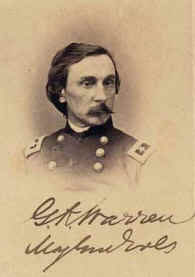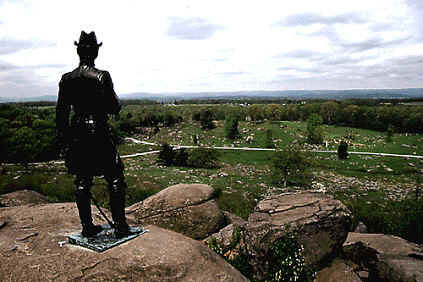 |
| Warren |
On the second day at Gettysburg, 2 July 1863, Gouverneur K. Warren, Chief Engineer, Army of the Potomac, noticed that Little Round Top, key to the Union defensive position, was undefended. He ordered troops to the hill in time to blunt Hood’s attack. Almost two years later on 1 April 1865 at the Battle of Five Forks, Major General Philip Sheridan, with Grant’s authority, relieved him from command and sent him to the rear.
When Warren graduated second in the West Point class of 1850 he accepted a commission as a second lieutenant in the Corps of Topographical Engineers. In the years prior to the Civil War he worked with Andrew Humphreys on the Mississippi River, on transcontinental railroad surveys, and explored, surveyed, and mapped the trans-Mississippi West. At the start of the war he received a commission as a Lieutenant Colonel of Volunteers in the 5th New York Infantry Regiment, and by the fall he was a Colonel and regimental commander. Promoted to Brigadier General in September 1862 he served as Chief Topographical Engineer and then Chief Engineer, Army of the Potomac.
Promoted to Major General after Gettysburg, he commanded 2d Corps until March 1864 when Grant made him 5th Corps commander. He led the 5th Corps through the Union offensive from the Wilderness, to Cold Harbor, and into the Petersburg trenches. He must have done well because he was still in command when Grant began the offensive that led to Appomattox. Grant ordered an attack on the Confederates at Five Forks for 1 April with Sheridan in command of both his Cavalry Corps and Warren’s 5th Corps. Grant wanted Sheridan to push the attack and authorized him to relieve Warren if he got in the way.
Although Warren successfully defended his position against the Confederates, Sheridan and Grant thought he did not press the attack fast enough. At the end of the day, as Warren met Sheridan for what he thought was a celebration, Sheridan charged him with neglect during the battle, relieved him from command of 5th Corps “for cause,” and ordered him to report to Grant. Warren asked for a Report of Inquiry, but the end of the war, Lincoln’s assassination, and Johnson’s impeachment all got in the way.
Warren reverted to his Regular Army rank of Major, CE, and went back to work on the Mississippi River. In July 1866 he was assigned to serve as the first “Engineer in Charge” of the Corps’ new office in St. Paul, Minnesota, where he served until May 1870. He then was in charge of engineer operations along the New England coast with headquarters at Newport, Rhode Island. It took the Army until 1879, after Grant’s two terms, to grant Warren’s request for a hearing. The board finally published its findings in November 1882 exonerating Warren of any neglect at Five Forks on 1 April 1865.
However, it was too late for Warren. He died three months earlier on 8 August 1882. At his request his family buried him in civilian clothes and without military ceremony at Newport. He felt disgraced by his relief on the field of battle. Ironically, however, in 1888 a bronze statue of him in uniform as Chief Engineer, Army of the Potomac, was placed at Little Round Top, the key position he saved on the second day at Gettysburg.

Bronze statue of Chief Engineer Gouverneur K. Warren on Little Round Top
* * *
July 2002